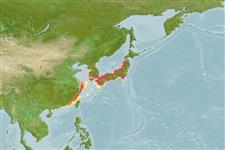Common names from other countries
Пластиножаберные (акулы и скаты) (sharks and rays) >
Carcharhiniformes (Ground sharks) >
Triakidae (Houndsharks) > Triakinae
Etymology: Triakis: tri-, from tres (L.), three; akis (Gr.), point, referring to each tooth consisting of one large central cusp flanked on by both sides by a small cusplet. (See ETYFish); scyllium: From skylion, Greek for dogfish or small shark. (See ETYFish).
More on authors: Müller & Henle.
Environment: milieu / climate zone / depth range / distribution range
экология
морской; солоноватоводный демерсальный. Subtropical; 48°N - 20°N
Northwest Pacific: southern Siberia to Taiwan (Ref. 244). Nominal records from the Philippines (Ref. 13563).
Length at first maturity / Size / Вес / Возраст
Maturity: Lm 103.5, range 99 - 108 cm
Max length : 150 cm TL самец/пол неопределен; (Ref. 244)
Found on the continental and insular shelves, often occurring in shallow water close inshore. Prefers estuaries and shallow bays, especially sandy and algal-covered areas and eelgrass flats. Feeds on small fishes and probably crustaceans and other benthic invertebrates. Often solitary, though some may cluster in resting areas on bottom. Ovoviviparous (aplacental), with 10 to 20 young in a litter. Meat is regarded as of inferior quality.
Life cycle and mating behavior
Maturities | размножение | Spawnings | Egg(s) | Fecundities | личинки
Ovoviviparous, embryos feed solely on yolk (Ref. 50449).
Compagno, L.J.V., 1984. FAO Species Catalogue. Vol. 4. Sharks of the world. An annotated and illustrated catalogue of shark species known to date. Part 2 - Carcharhiniformes. FAO Fish. Synop. 125(4/2):251-655. Rome: FAO. (Ref. 244)
Статус Красного Списка МСОП (Ref. 130435)
CITES (Ref. 128078)
Not Evaluated
Использование человеком
рыболовство: не имеет хозяйственного значения
дополнительная информация
инструменты
Специальные отчеты
Скачать в формате XML
ресурсы в Интернет
Estimates based on models
Preferred temperature (Ref.
115969): 14.8 - 21.8, mean 18.8 (based on 52 cells).
Phylogenetic diversity index (Ref.
82804): PD
50 = 0.5312 [Uniqueness, from 0.5 = low to 2.0 = high].
Bayesian length-weight: a=0.00240 (0.00110 - 0.00521), b=3.14 (2.96 - 3.32), in cm Total Length, based on LWR estimates for this (Sub)family-body shape (Ref.
93245).
Trophic level (Ref.
69278): 3.8 ±0.2 se; based on diet studies.
устойчивость к внешним воздействиям (Ref.
120179): низкий, минимальное время удвоения популяции 4.5-14 лет (Fec=10; K=0.16; tmax=20.6).
Fishing Vulnerability (Ref.
59153): High vulnerability (64 of 100).
